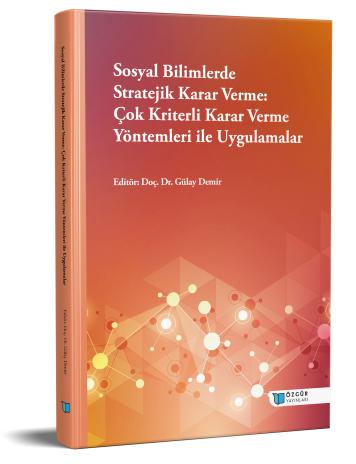
CoCoSo Tekniği ve Sosyal Bilimlerde Bir Uygulama Örneği
Şu kitabın bölümü:
Demir,
G.
(ed.)
2025.
Sosyal Bilimlerde Stratejik Karar Verme: Çok Kriterli Karar Verme Yöntemleri ile Uygulamalar.
Özet
Çok kriterli karar verme (ÇKKV) alanında yaygın olarak kullanılan geleneksel tekniklerin (TOPSIS, VIKOR ve AHP gibi) yetersiz kaldığı noktaları tamamlamak adına geliştirilmiş bir teknik olan Birleşik Uzlaşma Çözümü (CoCoSo) tekniği, Ağırlıklı Çarpım Modeli (WPM) ve Basit Katkılı Ağırlıklandırmayı (SAW) birleştirerek doğrusal ve çarpımsal modelleri dengelemekte, ve böylelikle de esnek ve dengeli bir çerçeve sağlamaktadır. Tekniğin metodolojisi beş ana aşamadan oluşmaktadır. Bunlar sırasıyla; karar matrisinin oluşturulması ve normalleştirilmesi, eklemeli ve çarpmalı performans puanlarının hesaplanması, üç farklı toplama stratejisinin kullanılması ve kapsamlı bir sıralama endeksinin üretilmesi olarak bilinmektedir. Bu yapı, sıralamanın tersine çevrilmesi ve ağırlık değişikliklerine duyarlılık gibi sorunları azaltarak sağlam ve tutarlı sonuçları garanti eder. CoCoSo, verimlilik ve eşitlik ya da anlık kârlar ile uzun vadeli sürdürülebilirliğin dengelenmesi gibi zor seçimlerin sıklıkla birbiriyle rekabet eden faktörlerin tartılmasını gerektirdiği sosyal bilimlerde son derece iyi performans göstermektedir. CoCoSo, hesaplama verimliliği, çeşitli koşullara uyarlanabilirliği ve diğer ÇKKV metodolojileriyle birlikte çalışabilirliği nedeniyle kamu yönetimi, sosyal politika, şehir planlama ve sağlık hizmetleri değerlendirmeleri için esnek bir tekniktir. Tüm bunların yanında, eksiklikleri arasında kesin kriter ağırlıklarına bağımlı olması ve aşırı öznel veya nitel verileri yönetmedeki zorluklar yer almaktadır. Normalleştirme tekniklerinin standartlaştırılması ve bulanık veya sezgisel bulanık kümelerle entegrasyon gibi gelecekteki gelişmelerle etkinliği daha da artırılabilir. CoCoSo, çok yönlü karar verme zorluklarını metodolojik titizlik ve pragmatik esneklikle ele alarak kanıta dayalı ve katılımcı karar vermeyi teşvik eder. Belirsizliği ve geniş bir paydaş yelpazesini ele alma kapasitesi, onu zorlu sosyal bilim konularını ele almak için önemli bir teknik haline getirmekte ve ÇKKV literatürüne ve uygulamasına önemli bir katkı sağlamaktadır.

